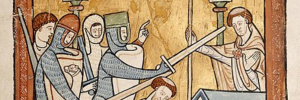The construction of Cannon Street railway station in 1866 obliterated the last remains the Steelyard, the chief entrepôt of the Hanseatic League in England. The League was a commercial informal empire, running its overseas outposts, such as that in England, in a similar way to the way the later European imperial powers in the nineteenth century ran their Asian trading concessions.
German expansion to the east in the twelfth and thirteenth by peasant settlement and military conquest helped lead to German domination of the Baltic, and the creation of a string of German, or German-dominated cities and towns around the edge of the sea. By the mid-fourteenth century their mastery of the littoral was complete. These cities, led by Lübeck, opened up whole new areas to western Europe. Among the towns were Rostock, Wismar, Stralsund and Danzig which were existing settlements, colonised by Lübeck. Riga was founded a military order, the Knights of the Sword, and further German towns were founded in Estonia, at Reval (Tallinn), Narva and Doormat. Most of these urban settlements were solidly German, even if their hinterlands remained mainly Slavic. But even where the Germans were a minority, as at Reval, they dominated the government of the towns.
The Germans established a near monopoly on the Baltic trade, in parallel to Venice and Genoa’s domination of the southern, more prosperous European ‘lake’, the Mediterranean. Though the Baltic’s products were in comparison low value, they were essential. From the end of the thirteenth century the Baltic was Europe’s main source of grains: wheat, barley and rye. These played a lesser role in Hanseatic trade with England than elsewhere, but were still significant. Of more importance to the English, were the area’s other products: timber, flax, hemp, pitch, tar, wax, metals, and furs. The latter came largely from the Hanse’s most easterly point of contact, Novgorod. In addition to supplying goods from the Baltic, the Hanse was also important for the supply of Rhenish wine to England from the Low Countries, and later when the English lost Gascony in the Hundred Years’ War, Hanseatic merchants moved into the export of French wines to England as well.
The first Germans to have a significant presence in England were from Cologne. Increasingly, though, from the early fourteenth century they were dominated by merchants from the Baltic. The Baltic towns in the fourteenth century came together to form a formal association, the Hanseatic League, to which Cologne was later admitted.
Its monopoly over the Baltic trade and wealth gave the League power, and helped create an informal empire marked out by its factories, or trading posts, plus their kontors, or chief trading posts, of which London was one. The name ‘Steelyard’ either came from a weighing arm, perhaps an English royal one that was earlier on the site, or perhaps more probably as a corruption of the German stahl Hof, or ‘hard court’. In addition to the London kontor, there were seven other, lesser Hanseatic settlements in England.
The kings Edward I, Edward II and Edward III, all borrowed heavily from the German merchants, and in return granted them privileges. Their greatest success in England, however, came with the restoration of Edward IV in 1471. The king’s comeback was financed by Hanseatic money, and his physical return to the country was brought about in Hanseatic ships. A grateful Edward confirmed the German merchants’ privileges and granted them an indemnity. It helped too, that in dealing with monarchs, it was in the latters’ interest to ensure the continuance of an alternative source of funding to their own native merchants.
From 1347 English merchants had to pay 1s/2d on each undyed cloth they exported, other foreigners 2s/9d, while the Hansards paid only 1s/-. (Source: G Scammell: The World Encompassed). Through their privileges they were able to muscle in on the return trade to the Baltic in English cloth. By 1500 Hanseatic merchants were handling about a quarter of English cloth exports.
They were exempt from other local burdens, including local tolls on goods brought in for sale in London, and the payment of murage for the maintenance of the City’s walls. In return for this particular favour they were supposed to help maintain Bishopsgate, but this duty and their alleged failure to meet its requirements gave rise to much friction.
Their privileges meant that they were widely hated by Londoners, and the Steelyard was a walled and gated community. Inside there was accommodation for between 20 and 30 merchants, a communal dining hall, warehouses, a weighing house, a counting house (or bank), and a chapel.
The merchants of the Steelyard were able to regulate their own affairs. Disputes between Hanseatic merchants in London were settled by their own courts, and they had the right to elect their own alderman regulate their affairs and deal with the outside world. The community was headed by a governing council, chosen by the merchants and led by the alderman. The alderman was also granted some authority over adjudicating disputes between merchants and Londoners.
By the sixteenth century, the Hanse was in decline. It was increasingly unable to impose its will on the increasingly centralised and powerful states of Denmark and Sweden. Later on the Dutch would impose their own monopoly on the Baltic trade. In 1551 their privileges in England were revoked and by the early part of Elizabeth’s reign German merchants had lost their dominance over English cloth exports to north-eastern Europe. English anger over Hanseatic trade with the Iberian peninsula in the latter part of her reign, at a time of English war with Spain, led to their expulsion in 1598.
Some Germans trickled back under James I, and though the original buildings were destroyed in the Great Fire, the site was rebuilt by German merchants, before becoming a yard for naval stores. The last meeting of the Hanseatic League’s central assembly the Landestage (which was never that powerful) occurred in 1669, with the cities of Bremen, Lübeck, and Hamburg, maintaining vestigial ownership of the London site until they sold up to the South Eastern Railway.
Join Ian on his Medieval London walking tour



